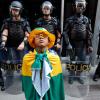Big Ears Festival in Multimedia Review: Body/Head, Tim Hecker, John Cale and More
Editor's note: The Big Ears Festival took place Mar. 28–30 in Knoxville, TN, showcasing a wide-ranging set of experimental and other such forward-thinking art and music. Here is part one of Flagpole's review.

Photo Credit: Rachel Gibson
oh what big ears you have
and she said, "it's better to hear you with"
tell you what
big ears you have
…
and i said, "hey Tennessee"
your big ears thought of us
allowed us to hear some great human beings
doing their own great thing
what their brain allows them to sing
and turn into music plain
that be soothin' to my ears
what big ears you have
better to hear, better to hear…
"Can you believe I just thought of that?" Lonnie Holley coyly remarked after his opening number on Sunday. His flippant dismissal belied what was actually a refreshing and poignant distillation of a weekend laden with aurally challenging and otherwise complex musical presentations. In the midst of processing the work of master after master, Lonnie's little dose of levity seemed to allow the greater brilliance of the experience to sink in a little deeper.

Photo Credit: Rachel Gibson
In retrospect, I feel as though the arc of programming at least temporarily enhanced my sense of hearing, and I think it was by design. The Times wrote, "Big Ears seems to be a festival about the experience of listening," and I couldn't agree more—at least, that's the way it went down. Audiences were consistently rapt and intently focused on the subtle shifts and underlying themes communicated by performers, rendering themselves at times a collaborator as much as members of the ensemble on stage. It was a participatory experience, even if that participation was simply a willingness to try. Occasionally, this participation was more direct: Jonny Greenwood guided smartphone owners to a URL that filled a historic theatre with sound from 1,000 tiny speakers at the close of his first appearance on Saturday.
This (relatively) atypical interaction with a series of rooms that might otherwise intimidate or stifle was another hallmark of the event. Free-flowing migration between bar, club and theater meant that in-house staff was a little more hands-off and that audience members were a little more comfortable with their surroundings. Instead of coattails and lobby-bound champagne, the breathtaking Tennesse Theatre was host to taps of Budweiser and about 500 vaporizers.
The Bijou Theatre, akin in style and size to our own Morton, was crammed with a sound system that could have run an outdoor stage at Bonnaroo, and several artists pushed it to its limits. The sonics in nearly every venue were fantastic, as was the interior architecture. Scruffy City Hall resembled something of a medieval downtown church and inspired Lonnie Holley to dedicate a song to whomever preserved it.

Photo Credit: Rachel Gibson
But the aforementioned Tennessee was far and away the crown jewel of the area. From outside, the unassuming brick structure did little to suggest what might lie within, save a Fox-style bulb marquee above the street. Inside however, the colors, textures, and curves surpassed even those of the Fox, and just about every other theatre I've visited. The ceiling was constantly alive with movement, swimming in a recessed and re-lit ocean of blues, no matter your state of mind. The glorious proscenium made one long for ancient unwritten plays to be performed. Its presence was that of a divine organism, completely open to us, a Fabergé womb that I never wanted to leave.

Photo Credit: Rachel Gibson
This isn't to say the festival completely transcended the social patterns surrounding these types of places and performers. The audience, while ranging widely in age, did not vary as much in culture. The ticket prices and urban-only accommodations amounted to a minimum expense of around $350 for those purchasing (early bird) weekend passes and a cheap room—a hefty cost for those without media credentials. In the context of for-profit major events (like I said, not bucking the trend), this is still fairly average. It didn't take away from my experience; I still felt like something good for people and culture was happening, but it did make me wish that more people—and a wider range of culture—could have accessed it. It's my hope that it will extend more freely into the community in the future.

Photo Credit: Rachel Gibson
While Big Ears isn't revolutionary in structure, it doesn't seem done evolving, and it deserves an enormous amount of respect for its commitment to resistance thus far. The event has resisted pressure from all sides, not the least of which is location. It's commendable that AC Entertainment would decide to keep the full girth (not just an offshoot) of this happening in its own Southern town. It's doubtless that many have suggested it be relocated to a larger metropolis, one with a "history" of supporting experimental artists. This is a tired and socially detrimental notion of place that deprives our national geography of the avant-garde and compounds the alienating connotation that many have of such work.

Photo Credit: Rachel Gibson
In the same light, I appreciated that the program wasn't overwrought with stuffy, academic thinkpieces nor immature, half-understood appropriations of the masters (like so many "noise" shows I've seen over the last 10 years). These were the masters themselves, fully present, making visceral art. The work we saw was developed enough to withstand and provoke deep analysis, yet immediate and expressive enough for one to simply feel its immense worth. Which is to say, no specific background was required to get the most out of the sound. This may have been the foremost accomplishment of the booking—it invited in any ears to be stimulated and educated, free of judgement.
Between the opening performance consisting of the simple act of hand-clapping (Steve Reich), and the extraordinary closing feat that is "Music for 18 Musicians," each work found space to be heard and appreciated.

Photo Credit: Rachel Gibson
Following the lesser of two performances of Reich's "Clapping Music," the Knoxville Museum of Art, the only venue more than a few hundred yards from another, treated attendees to an especially Havens-esque performance by Laraaji. The former Brian Eno collaborator and insightful guru performed several times over the weekend, including a laughter meditation workshop on Saturday morning that yours truly was loath to miss while recharging a battery. His partner Arji carried rhythm blissfully on a range of ear-tickling acoustica while his thunderous and serene voice competed with the cheapest beer of the weekend and attendees distracted, verbal acknowlement of the who's who of the room.

Photo Credit: Rachel Gibson
We split from the white-wall affair in hopes of having Stephen O'Malley kick some reality back into our teeth, and he delivered with signature authority. The stage for the SunnO))) co-founder consisted of four Orange 4 x 12s, two Ampeg 8 x 10 bass rigs and a Fender Pro Reverb, all of which were mic'ed and intensified in the PA. It was fucking loud—and this was the smaller of two setups I saw O'Malley employ.
At times, it felt as though he was playing the six walls of the venue instead of the six strings on his guitar. He slowly wove frequencies and textures into a mobile roar that snaked off of the surfaces in the room and seemed to increase simultaneously in density and range. We left a few minutes early to try and eat before the next show, and could still hear the low end from the patio across the street.

Photo Credit: Rachel Gibson
Colin Stetson occupied the same room shortly after, and we decided to take a new vantage point as a way of refreshing our ears. Stetson's performance was dazzling. I had appreciated his recorded works, especially Judges, but hadn't previously been inspired by the breadth of his repertoire. The controlled yet dizzying cycles of sax that sprang from his lungs carried traditions of jazz, minimalism, drone and electric guitar.
Stetson performs using one instrument at a time, without loops, but with about eight microphones. One is taped to his throat so that he can "sing" while he plays, and another is on the fingerboard of the sax to amplify the percussive tapping of his rhythms. Even still, I was unsure if he actually had four mouths somewhere else on his body. At times he exuded a prehistoric energy, as though blowing through a mammoth tusk at the dawn of time; at others he sounded like Reich working in a free-jazz band. This sense of primitive-futurism was a tone echoed throughout the weekend.

Photo Credit: Rachel Gibson
I caught about half of Kim Gordon's Body/Head project, about half of which sounded as awesome as her past work. The attitude, however, was on point the whole time. Gordon's voice was cool and confident as it rang out over slashing, metallic guitars and tremolo-stuttered harmonica. She performed in front of a pretty underwhelming video saga featuring slow, close-facial shots of a model and her photographer, documenting their dysfunctional collaboration. Unfortunately, I think that most people had the same idea we did, and when we turned to leave and find John Cale, I wondered how long it had been since she played to a room so empty.

Photo Credit: Rachel Gibson
The inimitable Mr. Cale exceeded all expectations. His voice is stronger, in a traditional sense, than it may have been his entire career prior. He sang with strong conviction, controlled vibrato and stirring emotion. He and his four-piece band rearranged classic songs and new works with youthful buoyancy and abandon. Occasionally, he brought on a line of backup singers, whose parts became more interesting as the set progressed. He ventured into pieces about Lou and even struck up a creative cover of "I'm Waiting for the Man" that almost snuck up on the audience. His warmth and wisdom shone on the room, as did his lasting relevance and present innovation.
With eyes now full of soul, we sat down in the front-center of the balcony at the Bijou Theatre and took a truly transportive aural journey with Tim Hecker. This was easily the loudest and most overwhelming presentation we had been witness to yet. Hecker performed in pitch dark, center stage. The set crept slowly in from inaudibility to total immersion over the first few minutes, after which there was no exit. The fidelity and sheer volume in the space rendered sounds within touching distance, and in clear physical perspective of the listener. Hecker's precise sculpting of his source materials became radiantly clear as he slowly filled the entire audible frequency range without any obscurity. He used impossibly-clear electronic tones, samples of instruments (Conrad's "Four Violins" maybe?), and outrageously deep, oceanic bass to deliver a truly remarkable, unique, and unforgettable live experience. It couldn't have mattered less that it was one man and some circuits in the dark; it was spiritual and completely fresh.











comments